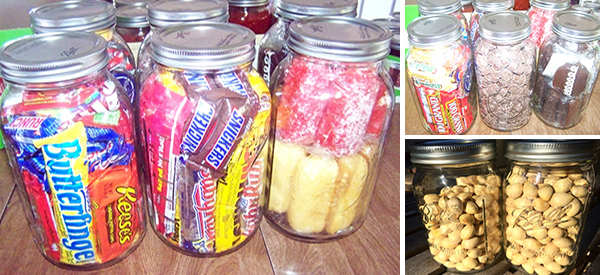As we work to build up our food stores, the most important things I can put back are foods that are nutrient-dense and will keep our bodies in tip-top condition. The ultimate goal is to have a supply of healthy foods loaded with proteins, fats and carbs that fulfill the nutritional needs of your family. What about your emotional needs, though?
If worse comes to worst and you’re required to live off your survival food storage, whether it’s because of an outside disaster or a more personal one like job loss, having some cozy, familiar snacks that are simple to eat and don’t require much prep could go a long way towards helping you maintain morale. Those types of convenient snacks can be tough to store, though.
How can you preserve these types of foods, whether it’s for your survival stores or just to make sure you don’t waste any of them when buying in bulk? I’ll tell you.
Vacuum Sealing
Vacuum sealing, the same way many store-bought foods are packaged, works great for preserving dry snacks like trail mix and potato chips. It’s perfect for almost any snacks that don’t require refrigeration, like chocolate, candy, dried fruits, other dehydrated foods, cereal, cookies, seasonings, grains, and lots of other foods. You can expect foods to keep for at least a few years this way, depending on your method. Here are a couple ways you can vacuum seal food items in your own home.
Vacuum Sealing in Jars
With a Food Saver jar sealing kit or another similar vacuum sealer attachment for jars, you can use regular Mason jars to preserve almost any dry snack you could think of so long as it will fit in the jar. This is perfect for long-term storage of all kinds of snacks, like cheesy corn chips, chocolate chips, nuts, and more. It’s a great method for every-day storage and making sure your bulk foods last longer, because the containers are reusable – so that you aren’t shelling out cash every time you use this method. Plus, many of us have a decent stash of Mason jars already.
You simply put together the jar sealing attachment, hook it up to the vacuum sealing machine, fill the jar to between ½ inch and one inch below the top of the jar, place a lid (but not a ring, yet) on the jar, place the jar sealing attachment firmly over the top of the jar, and turn on the machine to do its work. Each vacuum sealing machine will have some unique directions that you should carefully follow for the best results and to make sure your vacuum sealing is done safely.
If you’re planning on vacuum sealing jars with significant amounts of powdery substances, like a dry soup mix, you’ll want to take precautions to make sure that the powder doesn’t get sucked out of the jar, ruin the jar’s seal, and potentially ruin your vacuum sealing machine.
Vacuum Sealing in Bags
You can also vacuum seal dry foods in bags with a vacuum sealing machine and specially designed bags or rolls of heavy plastic wrap meant for vacuum sealing. Follow the directions on your particular model of vacuum sealer for the best results. You can expect your bagged, vacuum sealed dry foods to last between a year and three years.
The real downside to this method is that the bags you use to store vacuum sealed food are generally not reusable, plus they can be quite expensive. It makes this method sort of prohibitive for everyday storage of snacks.
Related: 7 Unusual Ways To Use Your Vacuum Sealer
Dehydrating & Freeze Drying
You can make delicious beef jerky or store extra fruits and veggies with a fairly long shelf life, by simply dehydrating them and then storing in a regular screw-top jar. Dehydrated foods can last for up to 30 years, depending on how it’s stored after drying and which food is being dehydrated.
Using a Dehydrator
You simply place food in a dehydrator and run it for the prescribed amount of time for the food you’re drying. You’ll likely find recommendations for how long to dry various foods, and how those foods should be prepared in your dehydrator’s manual. Many foods can be safely preserved in a dehydrator, including fruits, veggies, and meats. Jerky, flavored dried edamame, dried seasoned chick peas, and fruit leathers are all great examples of tasty snacks you can preserve using a dehydrator. Most foods with low fat content can be processed in a dehydrator.
Sun Drying
Some foods can be dried without the use of a dehydrator by simply placing them out in the open in a bright, sunny place, ideally one with a nice breeze and very minimal humidity. Ideally, only foods with high sugar and acid contents are dried this way, namely fruits like grapes, apricots, and blueberries. You’ll need the fruit, a drying screen set above the ground, plenty of time, and an ideal climate to pull this off.
Freeze Drying
While you’ll likely shell out a pretty penny for a freeze drying machine, it can be done at home. One neat thing about freeze dried foods are that they can often be reconstituted by adding back in the moisture that the freeze drying process removed. This method is also thought to do a superior job at preserving nutrition, and can be used for almost any food.
Related: 50 Foods to Dehydrate for Your Stockpile
The Best Way to Save Your Snacks
Choosing which method you want to use to preserve your favorite snacks, whether it’s for the worst case scenario or just to make sure you don’t have to trash the rest of the bag of your favorite nut mix simply because you couldn’t eat it fast enough, will be based on several factors. What means do you have available, which are you willing to acquire, what foods are you wanting to save, and how long do you want the food to last are all questions you should ask yourself. In embracing that you can store any food long-term, you can add variety and convenience to your survival food stores. Happy preserving!
You may also like:
 11 Food Storage Lessons Learned from WWI
11 Food Storage Lessons Learned from WWI
What An Emp Affects And How You Can Protect Your Electronics, Car, Mobile Phone (Video)
When Grocery Stores Go Empty; A Back Door Shopping Strategy
What Happens When You Eat Nothing but MREs
How to Keep Grains Edible and Fresh for Over 40 Years With Nitrogen












Rock candy is good for long term storage; it travels easy too since it isn’t prone to melting or spoilage. It’s handy to have in your vehicle too, just in case.
When on foot, keep it in your BOB where it’s easy to get to. You can suck on a piece for some extra energy.
Inasmuch as rock candy is pure sugar that has been crystalized from a super saturated sugar solution, if kept reasonably dry it should be good forever. Sugar doesn’t go bad or rot. I suppose if kept in a damp environment for a long enough period of time mold might grow on it but in 80 years I have never seen moldy sugar. Maybe it just never was around long enough for mold to get started. That’s a good suggestion, Hoosier.
Sugar’s a natural preservative. As long as you keep insects and damp away from it sugar will last just about forever, and it helps protect other foods too. Rock candy in a sealed container isn’t going to suffer much from anything, and it’s a great energy source.
Just be sure it’s individually wrapped. It will get sticky if kept in your BOB.
Also, if you don’t have a vacuum sealer you can order oxygen absorber packs and put those in the jar and it will seal the lid and absorb the oxygen. They are about twelve bucks for a pack of 100 at 100 cc. Plenty large enough to accommodate a quart jar. So that is a hundred quart size jars with sealed and preserved goodies of whatever you want to put in them.
Correction, check to see if one 100 cc pack is big enough for a quart jar, it may just be sufficient for a pint jar. I may have that info a little mixed up, but do check on that for yourself.
I use 300cc for everything thing from pints to quarts but they will handle up to a gallon. I get them from a Mormon website.
Why don’t you post the website. It would save lots of us from having to guess which one is the correct site.
I am sure it is Honeyville.
Sorry about that. I had it ready to go and forgot to put it in. The website for the 300cc oxygen absorbers is:
https://store.lds.org/webapp/wcs/stores/servlet/Product3_715839595_10557_3074457345616706370_-1__195877
i would recommend buying 100 packs by buying 10 packs of 10 100 cc oxygen asorbers it is much easier this way
I vacuum seal cookies all the time. A friend gave me a vacuum sealer a few years ago and it did not come with the attachment for jars, so right now, that is my only option.
You can buy the attachments separately. That’s how I got mine. Once you get used to sealing in jars you’LL wonder how you did without it!
I would be careful of anything with nuts. Had some go rancid.
That’s because of their fat content. Vacuum sealing should seriously slow down the process though, because it’s oxidization of the fat that makes them go rancid. Protecting food from oxygen will almost always let you store it for a lot longer.
Not to worry, you won’t eat many rancid nuts. One bite and you will know that something is seriously wrong. I had the good luck to experience some rancid peanuts just recently. Trust me, you won’t swallow any of the rancid nut. Your first action will be a hearty expectoration.
Oh and it won’t be, “Gee, I wonder if these are bad?” You will be absolutely certain instantaneously.
Don’t try vacuum sealing things like marshmallows or Twinkles. They don’t turn out well. Lol. I forgot they are mostly air! Poof!
Vacuum sealing a Twinkie! Had no idea Homer Simpson is a prepper.
Mmmm…..Twinkies!
I vacuum sealed flour, rice, cornmeal, cereal, and just about any other dry food you can name. When sealing fly away items such as flour, I cut copy paper circles, using a jar lid as a guide. I would then lay the paper on top of the flour. This kept sealing problems to a bare minimum.
Learning to make some faves from scratch might be good, too. There are a couple of recipe books that give you directions on making “fabulous fakes”. Preserving separate ingredients might be better for long-term storage. Ingredients could be home grown for some foods like tortilla chips and salsa or popcorn.
An advantage to making your own food from scratch is that you know exactly what is in it. Not only can most ingredients be easily stored, they can be home grown too.
I have been wondering lately if I should be using 02 absorbers or dessicant packs when vacuum sealing. Freezing nuts/seeds is the best way to extend shelf life. They go rancid because of the oils in them. When I vacuum seal more powdery items like flour/sugar/powdered milk etc. I have kept them in the original package, placed inside a vacuum bag with a pinhole in the original package.
Grammyprepper, how do you keep the flour from going rancid? I’d love to find a method that works. I once had some 50 pounds of flour, still in their original packages, vacuumed sealed. When I opened one, I found it had gone rancid. Upon checking all the others, they were rancid too. The only thing I could do was compost the mess. Now I store wheat berries and have learned to grind my own flour from them. Then I store it in the freezer which is the only way I can keep flour.
I have an opened 5# bag of flour sitting in my pantry that has been sitting there for at least five years. I really don’t know how long it has been sitting there. Unless I can’t tell rancid flour from good flour, it is still good. I am not sure it would rise if I tried to make bread with it, but for putting a crust on food items it still works. SoCal, unless one lives right by the beach, is semi-arid and humidity is invariably low and in the micro-climate where we live, temperatures are usually moderate. That may be the difference. Even when I lived in PA as a child I never remember my mother talking about rancid flour. Maybe I wasn’t paying attention or perhaps we used it up before it got rancid. I first read about rancid flour on this website. I’m not saying that it doesn’t exist, I just wonder if it is a climatic thing and in certain predominant weather conditions flour goes rancid and in others, not so much.
Maybe it is a thing where if you live in Florida, hot humid weather equals rancid flour. If you live in Barstow, CA, not so much.
LCC – You’re probably right that your location has a lot to do with it. I had not really thought much about location and the weather as prime factors causing it to go rancid but that does make sense. Even though I live in Appalachia, I don’t live very high enough on the mountain, only 1200 feet. Yesterday, here was below 30% in humidity and below 70 in temperature. Today, the humidity was nearly twice that and the temperature was nearly 90. Some fluctuations are common this time of year but rarely to this degree. That may be the big factor as to why I can’t keep flour, except in a freezer. The original 50 pounds of flour that I had to compost, I had brought from Kentucky when I moved. The heat and humidity there were a lot worse than where I live now and had probably started to degrade the flour long before the move. Guess the best thing I can do is just what I’m doing now – keep flour in the freezer.